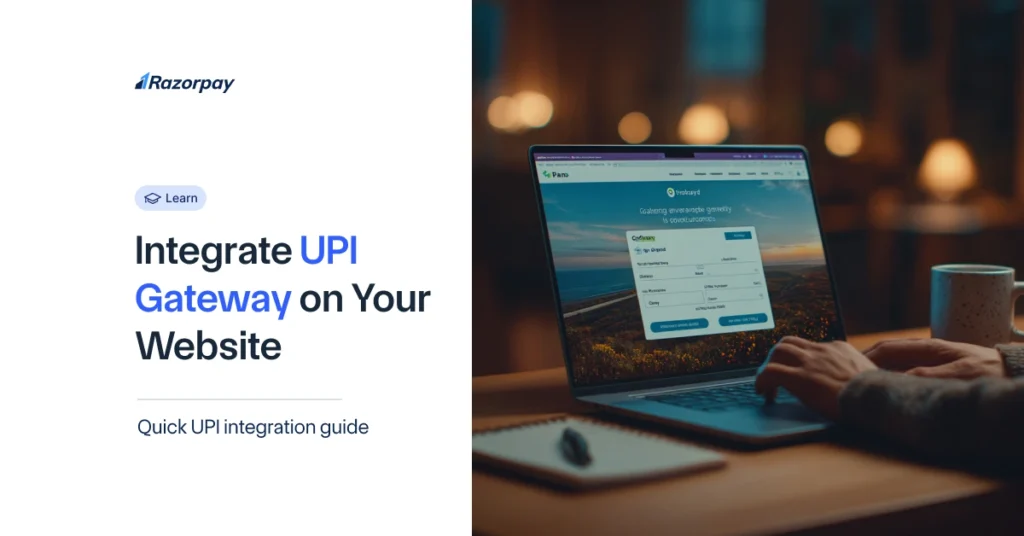When the NPCI introduced the UPI in India in 2016, it was a novel concept in an extensively cash-dependent country. Eventually, with regular updates and improvements to the system, UPI became one of the world’s largest online payment system. Today, UPI boasts of 500 million Indian users – a sign of it’s widespread adoption. The internet’s expansion to every nook and corner of the country has enabled merchants of all sizes to adopt the UPI as their preferred payment method, taking India closer to realising the dream of becoming a digitally forward nation. If you are a business owner wondering how to integrate a UPI payment gateway into your website, this article will shed light on the same.
Key Takeaways
Learning how to integrate the UPI payment gateway in website is essential in today’s age due to it’s popularity and widespread use.
There are three distinct methods – web collect, intent flow and QR-based payment.
Razorpay’s scalable API and compliance with PCI DSS makes it one of the most sought-after payment gateways by major businesses in India.
Why UPI Integration Matters For Merchants in 2025?
As Indian merchants migrate to online storefronts, the need to integrate these storefronts with UPI payment gateways has become the need of the hour. Integrating UPI with your website aids frictionless payments and reduced drop offs in a cost-efficient way. Here is why your business website must be integrated with UPI payment gateways.
Seamless, Instant Payments
One of the biggest challenges in the digital payment world is ensuring secure, seamless payments. Since UPI is a widely used payment gateway, it has deeper penetration in the Indian market.
Integrating your website with UPI payment gateway ensures instant, secure payments without saving card details or asking for OTP, making it a frictionless checkout experience.
Broad Acceptance
UPI is compatible with all mobile payment applications like GPay, PhonePe, Paytm, making it one of the most popular and versatile payment tools.
Due to it’s popularity, it is widely used across the country and preferred by people who do not own credit cards.
Cost-Effectiveness
As it was developed as part of the government of India’s initiative to popularize digital payments, the transaction fees are very minimal for different types of transactions.
Better Conversion Rates
As the UPI payment workflows are largely popular among customers, using UPI payment gateways ensure better conversion rates.
In addition to this, UPI also facilitates omnichannel acceptance – it can be accessed through the web, mobile or points of service.
UPI Payment Integration Methods for Websites
There are three different payment integration methods for online storefront websites.
Web Collect (Pull Flow)
In this method, customers can enter their UPI ID on the checkout page which then triggers a collect request being sent to the customer’s UPI application.
The customer opens their app, accepts the request and sends money through the payment app like GooglePay or PhonePe and completes their purchase.
This method is best suited for standard web checkout flows.
UPI Intent Flow (Mobile-Redirect)
When merchants use the UPI intent flow to integrate UPI payment gateway;
- Users select ‘UPI’ as their payment method
- They are directed to open the UPI app which is already populated with the transaction details.
- Once they finish transacting, they are automatically redirected to the checkout page.
- This payment method is useful for mobile-only users.
QR Code-Based Payment
In this method, merchants can dynamically generate a QR code on the checkout page, which the customer scans through any UPI app. With this step, the payment is made instantly.
This payment flow can be used to make payment through any channel, hence it is also termed as omnichannel mobile flow.
How To Integrate A UPI Payment Gateway into Your Website? Step-by-Step Integration Guide
Step 1: Choose a UPI Gateway Provider
The very first step is to consider your business needs, how much you can spend, security and speed while browsing for the best payment gateway providers. It is essential to ensure that the gateway complies with security standards such as PCI DSS.
Step 2: Onboard & Complete KYC
Once you have selected the payment gateway, share documents such as registration proof, GST/PAN details of your business, etc and complete the KYC requirements.
Step 3: Obtain API/SDK Access
Get access keys or SDKs—depending on whether you’re integrating via API or plugin.
Step 4: Integrate the Payment Flow
- Add Web Collect form or UPI button, or implement QR and Intent flows—based on chosen method.
Step 5: Backend Callback Handling
- Process UPI gateway responses (success/failure), then validate and update order status.
Step 6: Testing
- Use sandbox/test environment to simulate payments, validate flows, and ensure reliability.
Step 7: Go Live
- Launch on production, monitor transaction success rates, settlement timelines, and user feedback.
Why Choose Razorpay for UPI Integration?
- Unified Gateway: Supports all UPI flows—Web Collect, Intent, and QR—through one plugin or API.
- Quick Onboarding: Fast verification, developer-friendly sandbox, and minimal setup complexity.
- Dashboard & Reconciliation: Provides a consolidated view of UPI, cards, wallets with auto-reconciliation and reports.
- Instant Settlements: Access funds quickly with Razorpay’s settlement options.
- Security & Trust Signals: PCI compliance, secure SDK, and visible trust cues during checkout.
Conclusion
As time passes on, India is relying heavily on secure digital payments. UPI offers some of the best services to both consumers and merchants, paving the way for more secure and swift payments. Integrating a UPI gateway into your website also helps in optimising your checkout flow and helping reduce the dropoff percentage. To keep up with the increasing demand among customers and competition with your peers, consider integrating your online storefront with Razorpay’s payment gateway.
Ready to streamline your payments?
FAQs
Which UPI integration method is best for web vs mobile?
QR code-based integration is recommended for mobile based transactions while a web collect flow is more suited for web-based transactions.
Can small businesses use UPI payment gateway?
Yes, small businesses can use UPI payment gateway.
Are UPI flows secure and reliable?
UPI flows are subjected to timely updates to ensure compliance with secure payment standards like PCI DSS. Hence, it is a secure and reliable way to conduct business transactions. However, like many systems, it is susceptible to cyber vulnerabilities which can be tackled if algorithms are checked and counter measures are implemented with timely updates.
Does Razorpay support all UPI flows out-of-the-box?
Yes, Razorpay supports all major UPI payment flows out-of-the-box, providing a seamless and frictionless payment experience for businesses and customers alike.

